Using a CMMS software like Limble is the best way to manage all Maintenance, Repair, and Overhaul work. You can easily keep tabs on planned maintenance schedules, set up an efficient inventory system, and stay in control of all maintenance-related costs. It might sound biased coming from us, but we firmly believe that implementing CMMS is necessary for proactive, efficient, and cost-effective asset management.
Sometimes it can seem like managing all the work you have to do is a full-time job in itself. Maintenance calendars, budgets, work orders — it’s a lot to keep track of. A CMMS like Limble can do the heavy lifting for you.
Automated planned maintenance
As you know, it’s much easier to fix something when you can catch the problem before you head into disaster territory. Implementing a preventive maintenance program can help you do that — but it’s much easier said than done.
One of Limble’s most powerful features is the ability to help you automate preventive maintenance schedules. No more paper, no more whiteboards, no more Excel spreadsheets.
In Limble, you can:
- Enter a preventive maintenance routine once and never have to think about it again.
- Set the schedule to daily, weekly, monthly, yearly, or based on events or meter readings.
- Attach a standard operating procedure checklist.
- Receive automated notifications when a PM is created or due.
- View all open work and upcoming PM schedules on our easy-to-use calendar
- Quickly change due dates by simply dragging and dropping within the calendar.
- See all completed work on the asset’s maintenance log.
The best part is that Limble requires little to no training to use. Watch how easy it is to build a PM in Limble:
Streamlined Work Order management
Limble can easily track all of your Work Orders and Tasks for you. And with Limble’s mobile-friendly app, you can see all the work that’s queued up, in progress, or completed on any device.
Take a look at everything you can do with Limble right from your phone:
- View all of your Tasks, including WOs, PMs, and Work Requests.
- Set Task priority, so the right work gets done first.
- View a calendar of current and upcoming Tasks.
- View critical KPIs such as actual completed work, time spent, and planned vs. unplanned work.
No more tracking down a technician to give you the status of the work. You can say goodbye to the long walks to look for forms at the office. Now, it can all be on your phone.

Maintenance workload overview inside Limble CMMS
Not missing (any) important Work Requests
Work requests come through many different channels: phone, email, someone complaining directly at you, etc. All these channels of communication help your team solve problems quickly. But it can be tough to manage when the information doesn’t end up in one central hub.
With a robust work order software, you can receive work requests in a way that helps your team get the work done much faster.
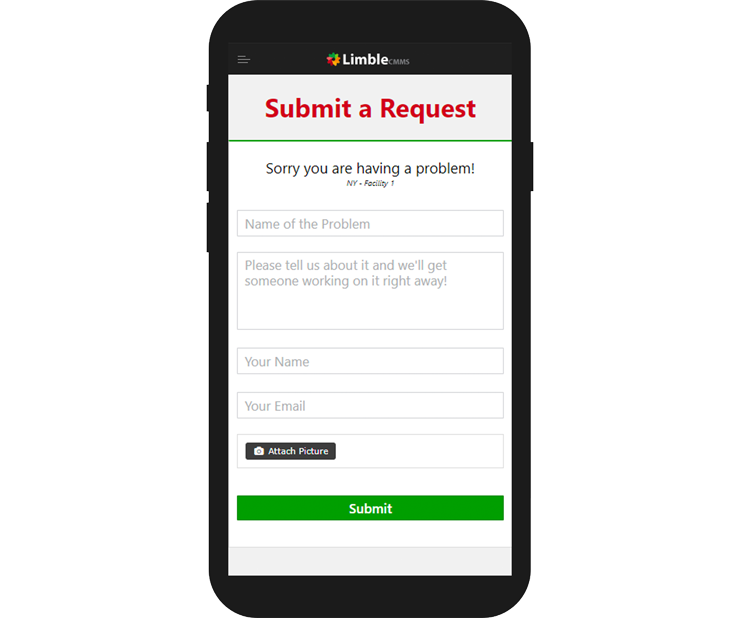
Submit maintenance tickets using Limble’s Work Request portal
With Limble, you can:
- Avoid the vast majority of duplicate work requests.
- Provide instant feedback to requestors that the solution to their problem may already be in progress.
- Facilitate instant communication between requesters on similar requests.
- Configure sensitivity levels and scope, so only requests in specific areas are compared against each other.
- Improve your requestor’s experience while saving your maintenance team time.
Managing spare parts inventory
Inventory can be an expensive pain in the side if not handled strategically. A CMMS can help.
On average Limble users reduce their inventory cost by 17%. Let’s take a look at how.
Not sure what parts you have in stock or where they are being used? Don’t know when your parts will run out or if your technicians will have the necessary parts to do their jobs?
Limble’s parts management features can help you solve those problems and more:
- Get email and push notifications to reorder when a part’s quantity is low.
- Quickly see if a part is in stock from inside a Work Order.
- Access real-time inventory updates as Work Orders or PMs use parts.
- Instantly view forecasting for a part to see how many parts you’ll use within the next year, and clear out inventory you don’t ever use.
- Find out where your parts are going, who uses them most often, and what it costs.
- Make your inventory easy to track and access with custom QR codes.
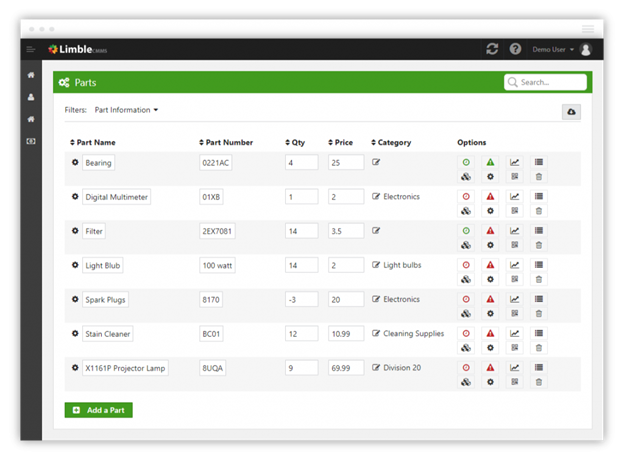
Inventory tracking inside Limble CMMS
Managing all of your vendors
Keeping track of all your vendors can be tough (is that drawer full of business cards really working for you?). With Limble CMMS, Vendors are fully and seamlessly integrated into your maintenance system:
- Store all Vendor information (names, addresses, emails, phone numbers, contracts, etc.) within Limble.
- Push out purchase orders directly to your vendors from Limble.
- Associate Vendors to Assets they maintain or Parts they supply.
- Automatically maintain a record of a Vendor’s time, Parts used, Invoices, and other desired data.
- Maintain an all-time history of all Work Orders that the Vendor has completed for your company.
- Gain insights into how much money you are spending on the Vendor
- Simplify communication with Vendors through detailed instructions, Limble comments, and automated email notifications.
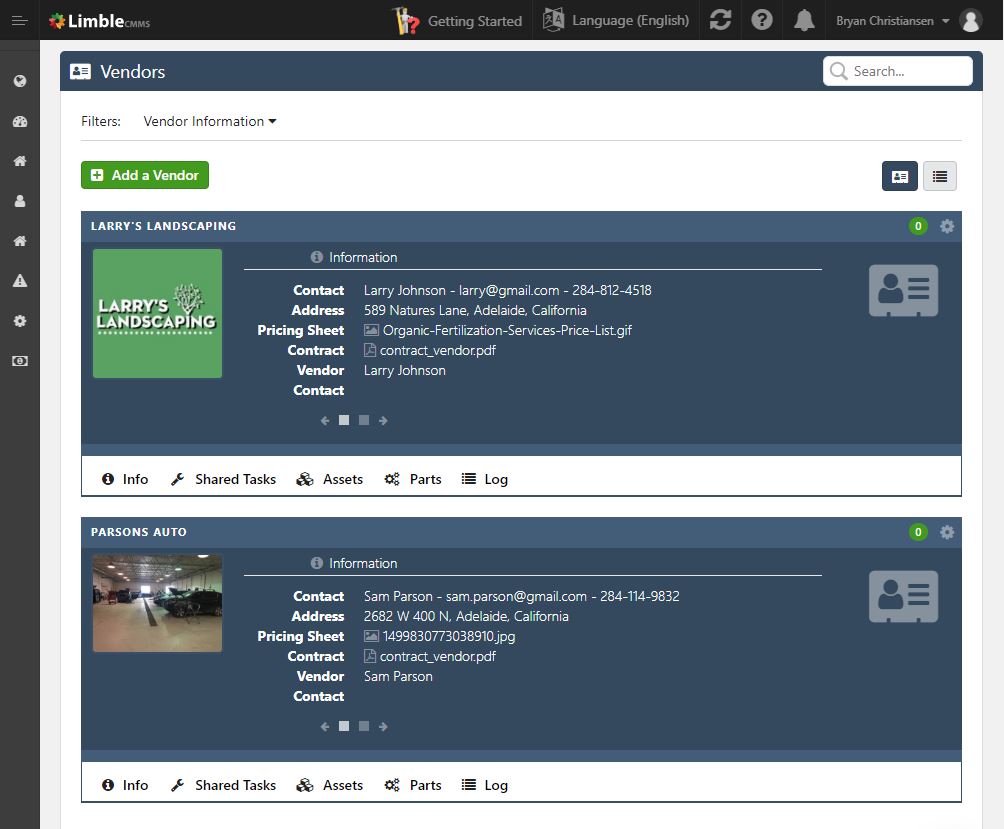
Vendor management view inside Limble CMMS
Assigning work
Of course, we can’t forget all the people that help you get all the work done. Can you imagine being a one-person show? No way.
It’s tough to keep track of who’s doing what when you’ve got a big team. With Limble, you can:
- Have work orders auto-assigned to the right technicians based on data in the work request
- Drag-and-drop to reassign work if team members are out or if staffing changes
- Automatically track how many hours your technicians are working and how much work they are completing with Custom Dashboards.
- Inspire team camaraderie, encourage productivity, and enjoy a little healthy competition with Custom Dashboards that show how many tasks each team member has completed.
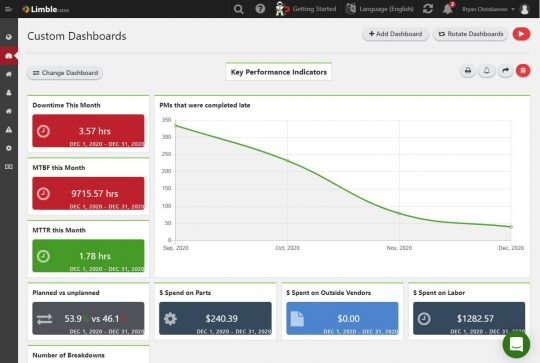
Track important KPIs in real-time with our Custom Dashboards
All of that being said, no two businesses are the same, so no two companies will manage their MRO the same. Here are a couple of examples to paint the picture for you.
Checklist for Creating a Preventive Maintenance Plan
Following a consistent Preventive Maintenance Plan can make life easier. Use this checklist to create your own!

MRO for University Campus Management
College and university campuses are unique when it comes to Maintenance, Repair, and Operations because there are so many wildly different kinds of facilities on campus. You’ve got state-of-the-art science labs, multiple athletic fields, acoustically-engineered performing arts halls, dormitories full of emotional support animals, and medical facilities where people’s lives are on the line — the list goes on.
Top priorities
The name of the game is keeping everything running at all times so that students, faculty, and staff can focus on education without interruption. No one wants to show up on the first day of Fall semester to find the HVAC system blowing hot air into their lecture hall. It’s history class, not a 300-person sauna.
But with the wide variety of facilities on a large campus, there’s an opportunity for a lot of things to go wrong at any given time, and that gets really busy.
What day-to-day looks like
Work requests. Lots of work requests. A campus maintenance team will get a broad span of requests that could include anything from moving a whiteboard or painting a room to adjusting the power supply on lasers that blast atoms apart.
If there’s any hope of tackling all those work requests, it’s imperative that your team has a way to record and track the tasks in a central hub. This makes it so everyone has the same information. Everyone on your team can know what needs to be done, how urgent it is, and who should be working on it.
With a digital Work Request system, this becomes a much simpler task. If you are not ready for a CMMS, you can look into free maintenance ticketing systems as a temporary solution.
Top challenges in the industry
Did we mention that campus maintenance is extremely busy? As much as a campus maintenance team would love to do all planned maintenance perfectly on schedule, it usually isn’t in the cards. The team falls behind in routine maintenance, which leaves room for things to break down… which further gets in the way of routine maintenance. A vicious cycle, indeed.
Additionally, each department on campus has wildly different needs to match the space they occupy. This might seem obvious, but when you think about the volume of people that a campus maintenance team serves, it’s enough to make your brain scramble.
Imagine — everyone comes hollering at you with their problems, and it’s your job to fix them. It’s your job to sort through all the noise, identify the most critical issues, develop a strategic solution, and deploy your team to tackle the challenge.
Good news: despite the many challenges of campus management, working at a university can be gratifying. You are literally providing the infrastructure that makes it possible for breakthrough research to happen and for an up-and-coming generation to find their sense of purpose.
MRO for a Wastewater Treatment Facility
Water — one of earth’s most precious resources. As it turns out, water requires a lot of maintenance to keep communities and their constituents safe and healthy.
Top priorities
The main goal is to keep critical systems running correctly at all times. Wastewater must get treated according to regulations to ensure public health and safety. When it doesn’t … Houston, we have a problem.
When wastewater isn’t handled properly, it can lead to hazardous situations like the spread of disease, ingesting toxic chemicals, and beyond. What starts as a maintenance issue at one wastewater plant can quickly devolve into a public health crisis. The stakes are high.
What day-to-day looks like
All MRO best practices revolve around preventive maintenance, but here, it’s the rule of law.
Preventative maintenance in a wastewater treatment plant occurs regularly, with some tasks occurring weekly, monthly, quarterly, or annually. The goal is to continue providing communities with safe, clean water. An added benefit is that it extends the life of the equipment and reduces costs that come with breakdowns.
In a wastewater treatment plant, everything is governed by a calendar that is connected to sensors and alarms. If something goes wrong, the maintenance team is quickly alerted. When it comes to repairing a problem, every action has a specific what-to-do-next checklist. The team, although small, is highly skilled and well-versed on every piece of equipment so they know how to tackle problems when they happen.
Top challenges in the industry
Now — just because we are prioritizing preventive maintenance doesn’t mean that there aren’t things out of our control that throw a wrench in your day-to-day plans.
One of the unique challenges in a wastewater treatment facility is dealing with ever-changing government regulations. It’s your job to translate those updates into infrastructure.
Here’s an interesting story: In 2009, Atlanta experienced some epic flooding. There was a wild storm with multiple days of heavy rainfall. The volume of the water was more than the local sewage system could handle. To make matters worse, old sewage systems in this area combined runoff with domestic sewage and industrial wastewater all in the same pipes. When the sewers overflowed, it exposed the community to untreated human waste and toxic industrial chemicals.

An overflowing sewer. Source: US Geological Survey
This type of combined sewer overflow (CSO) is an example of outdated infrastructure that creates real challenges for wastewater maintenance crews. All you maintenance people out there who update these essential systems and keep clean water running out of our faucets — you’re the real heroes.
Careers in Maintenance Repair and Operations
Wondering what a career in MRO might look like? If you’re interested, we have some good news. Nearly 60% of MRO professionals will retire within the next decade. Even now, companies are struggling to find the talent they need — which means there’s a massive demand for qualified professionals in this line of work.
Considering this, here’s a look at what a career trajectory in MRO might look like for you in an enterprise-level organization:
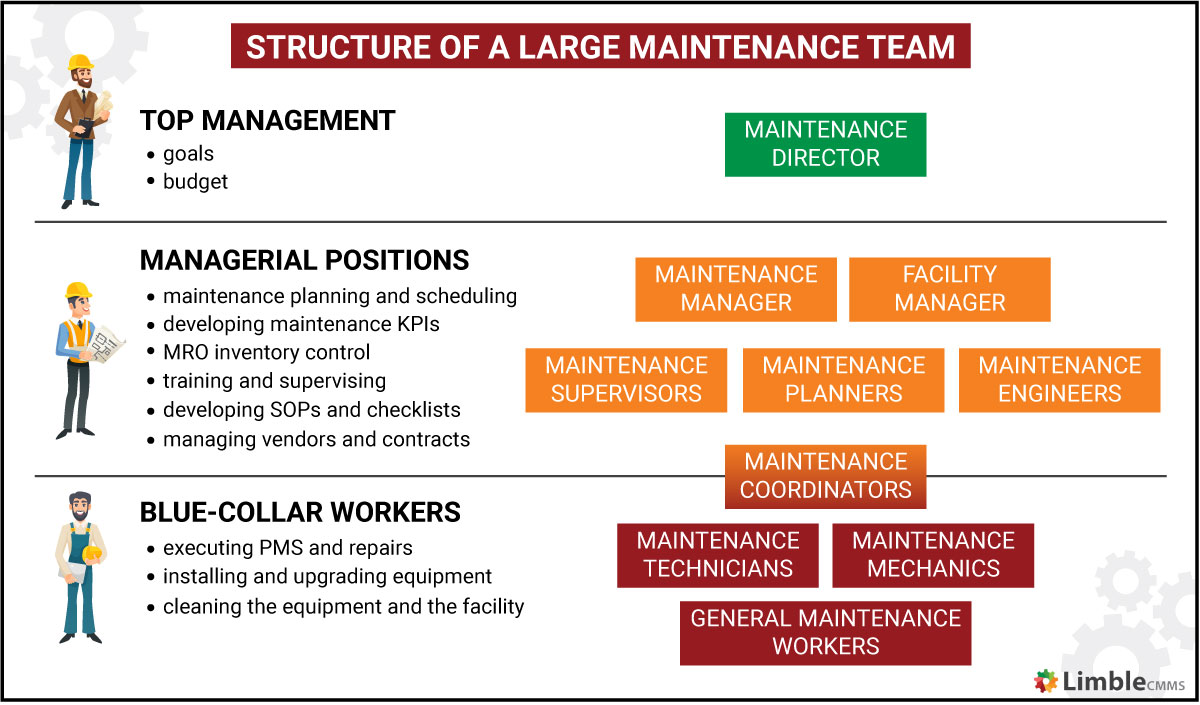
The exact set of available roles and their duties will depend on the size of the maintenance team and what industry we are talking about.
Over the years, we covered each of those job positions in depth. Many of them have significant overlap. Still, if it is a career you are considering, it is worth knowing the difference.
Each of the articles we link to below discusses required skills, main duties and responsibilities, and average salaries. Let’s start from the bottom:
- General maintenance worker
- Maintenance technician
- Maintenance mechanic
- Maintenance coordinator
- Maintenance supervisor
- Maintenance planner
- Maintenance manager/facility manager
- Maintenance director
This is not an end-all be-all list, but it covers all of the standard positions you can find in a maintenance department. Creating a balanced maintenance team is easier said than done, especially with the looming labor shortage.
For more information on how to build a cohesive team that matches the needs of your organization, read our How To Organize A Maintenance Department guide.

I am really grateful for you , it is really worthy article. Thanks a lot
Can you please guide me to more references or websites for MRO
Feel free to browse more through Limble blog. Most of our content is related to MRO in one way or another 🙂
I have read peer-reviewed scholarly articles and everything in my textbook on MRO and was just not getting it. Frustration and confusion shut me down from writing my paper. THANK YOU! Now it all makes sense, and I finally get it.
Thanks for sharing this blog. MRO’s strategy is an important part of most manufacturing and service businesses. Even if these items aren’t considered as a direct part of the assembled product, they help maintain appropriate operating standards, thereby ensuring that all different areas of the business have the functions required for normal operation.
Comments are closed.